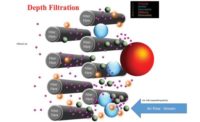Air acts like a fluid, flowing from a higher pressure to a lower pressure. If the amount of air brought into a facility is equal to the amount exhausted, the building is considered “neutral.” If more air is brought in than is exhausted, the facility is “positive.” And vice versa, if more air is exhausted than is brought in, it is “negative.” Different types of rooms are designed with different pressure requirements.
Negative air balance is extremely common, especially in older facilities that have undergone expansions or other process changes. A negative facility will draw in air from anywhere it can, including undesirable sources like truck docks, open doors, window cracks, and rooms of varying temperatures. This infiltration air is both unconditioned and unfiltered, creating the potential to bring in airborne contaminants. A properly installed and maintained makeup air system replaces the air that is expelled by a facility’s exhaust system, supplying conditioned replacement air that can be filtered, heated, cooled, or dehumidified.
Some of the most common problems that arise from an improperly balanced facility include severe energy inefficiencies, condensation, room temperature issues, food safety issues, and unsafe carbon dioxide levels.
SEVERE ENERGY INEFFICIENCIES
Proper air balance can significantly lower energy costs. A negative facility leads to drafts around doors and windows and infiltration of outdoor air creating additional loads on heating and cooling systems. Unintentionally pulling in warm, moist air into a refrigerated room can add significant load to the refrigeration system. In refrigerated rooms with an unavoidable requirement to exhaust large quantities of air, energy-recovery options are available to reduce the load on the refrigeration system.
CONDENSATION
Unbalanced facility airflow can cause serious condensation issues. Any time air comes in contact with a surface below the dewpoint of the air, condensation will occur. In certain plants, such as food-processing facilities, dripping water is a serious concern, as beads of moisture can become drips of contamination, with the condensation carrying dirt, microbes, and other contaminants. Condensation is not acceptable in a food-processing plant, and is a leading cause of downtime.
ROOM TEMPERATURE
Many facilities, such as pharmaceutical or food-processing facilities, require precise temperature and humidity control to ensure product safety and quality. A room with negative pressure will pull in air from surrounding areas, which are often maintained at different temperatures. Often, refrigeration systems are not designed to handle this additional load, and this can quickly cause problems in a room with a tight temperature and humidity tolerance.
FOOD SAFETY – AIRBORNE CONTAMINANTS
In meat-processing facilities, the direction that air flows is critically important. The air from kill floors and rendering areas must never flow to areas such as packaging, where the airborne bacteria could infect the final product. Air must go in the direction of clean to dirty, which is counter to the product flow. The cleanest areas of the facilities need to be maintained at positive pressure to prevent unwanted airflow into the clean rooms.
UNSAFE CARBON DIOXIDE LEVELS
The golden rule of dry ice — the solid form of carbon dioxide — is to always use it in a well-ventilated space. Dry ice is widely used in the food industry for cooling during meat processing, crust freezing, and packaging.
However, when dry ice sublimates, the room fills with CO2, which can become dangerous at any concentration above 0.5%. Breathing in too much CO2 can lead to headaches, muscle twitches, disorientation, brain damage, and even death. The key to prevention is adequate ventilation while maintaining a proper balance wherever CO2 is used.
ACHIEVING AIR BALANCE
To achieve air balance in an existing facility, you must conduct a room-by-room analysis to measure:
• Air supply
• Exhaust flow
• Airflow direction
•Total psychrometric condition (temperature and humidity)
•Each room’s pressure relative to surrounding rooms
All equipment that can be safely accessed must be measured, including:
• Operational supply/exhaust fans
• Process equipment supply/exhaust ducts
• Powered outside air intakes
• Makeup air units
• AHUs using outside air
After quantifying the existing air-moving equipment, the data can be analyzed and additional equipment can be installed to achieve a properly engineered air balance.
CONTROL SYSTEMS
Facilities can have large quantities of equipment contributing to the overall plant air balance. This equipment could run intermittingly or have variable flows, and it is critical to maintain proper air balance even as conditions change. Centralized control systems are necessary to adapt to these changes. These systems can sense pressure imbalances, alert plant personnel, and automatically make adjustments to correct the imbalance. ES






